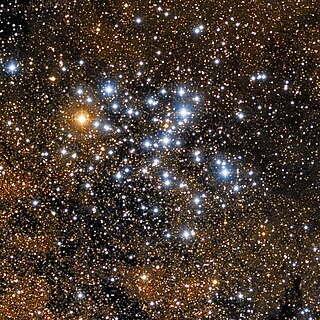
The Butterfly Cluster is an open cluster of stars in the southern constellation of Scorpius. Its name derives from the vague resemblance of its shape to a butterfly. The Trumpler classification of II 3 r encodes it is rich in stars, ranks II out of IV for disparateness and greatly mixes bright with faint components. It is 3.5° to the northwest of Messier 7, both north of the tail of Scorpius.
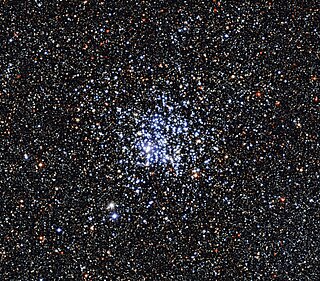
The Wild Duck Cluster is an open cluster of stars in the constellation Scutum. It was discovered by Gottfried Kirch in 1681. Charles Messier included it in his catalogue of diffuse objects in 1764. Its popular name derives from the brighter stars forming a triangle which could resemble a flying flock of ducks. The cluster is located just to the east of the Scutum Star Cloud midpoint.
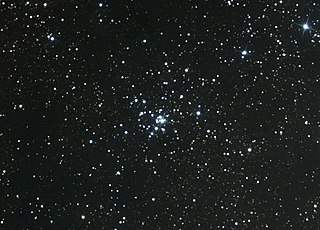
Messier 21 or M21, also designated NGC 6531 or Webb's Cross, is an open cluster of stars located to the north-east of Sagittarius in the night sky, close to the Messier objects M20 to M25. It was discovered and catalogued by Charles Messier on June 5, 1764. This cluster is relatively young and tightly packed. A few blue giant stars have been identified in the cluster, but Messier 21 is composed mainly of small dim stars. With a magnitude of 6.5, M21 is not visible to the naked eye; however, with the smallest binoculars it can be easily spotted on a dark night. The cluster is positioned near the Trifid nebula, but is not associated with that nebulosity. It forms part of the Sagittarius OB1 association.

Messier 23, also known as NGC 6494, is an open cluster of stars in the northwest of the southern constellation of Sagittarius. It was discovered by Charles Messier in 1764. It can be found in good conditions with binoculars or a modestly sized telescope. It is in front of "an extensive gas and dust network", which there may be no inter-association. It is within 5° the sun's position so can be occulted by the moon.

Messier 26, also known as NGC 6694, is an open cluster of stars in the southern constellation of Scutum. It was discovered by Charles Messier in 1764. This 8th magnitude cluster is a challenge to find in ideal skies with typical binoculars, where it can be, with any modern minimum 3-inch (76 mm) aperture device. It is south-southwest of the open cluster Messier 11 and is 14′ across. About 25 stars are visible in a telescope with a 150–200 mm (6–8 in) aperture.
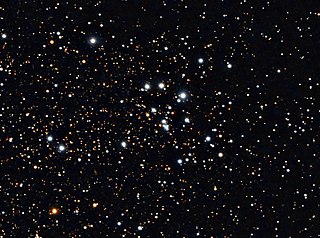
Messier 18 or M18, also designated NGC 6613, is an open cluster of stars in the constellation Sagittarius. It was discovered by Charles Messier in 1764 and included in his list of comet-like objects. From the perspective of Earth, M18 is situated between the Omega Nebula (M17) and the Small Sagittarius Star Cloud (M24).

Messier 35 or M35, also known as NGC 2168, is a relatively close open cluster of stars in the west of Gemini, at about the declination of the sun when the latter is at June solstice. It was discovered by Philippe Loys de Chéseaux around 1745 and independently discovered by John Bevis before 1750. It is scattered over part of the sky almost the size of the full moon and is 2,970 light-years away. The compact open cluster NGC 2158 lies directly southwest of it.
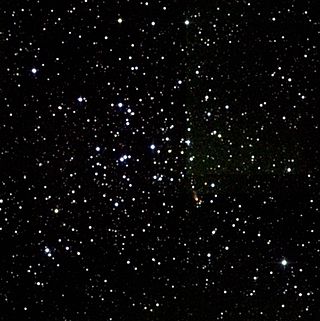
Messier 36 or M36, also known as NGC 1960, is an open cluster of stars in the somewhat northern Auriga constellation. It was discovered by Giovanni Batista Hodierna before 1654, who described it as a nebulous patch. The cluster was independently re-discovered by Guillaume Le Gentil in 1749, then Charles Messier observed it in 1764 and added it to his catalogue. It is about 1,330 pc away from Earth. The cluster is very similar to the Pleiades cluster (M45), and if as far away it would be of similar apparent magnitude.

Messier 37 is the brightest and richest open cluster in the constellation Auriga. It was discovered by the Italian astronomer Giovanni Battista Hodierna before 1654. M37 was missed by French astronomer Guillaume Le Gentil when he rediscovered M36 and M38 in 1749. French astronomer Charles Messier independently rediscovered M37 in September 1764 but all three of these clusters were recorded by Hodierna. It is classified as Trumpler type I,1,r or I,2,r.
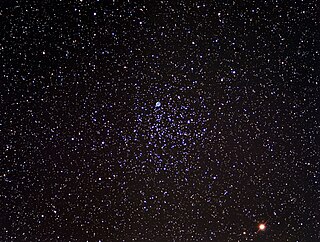
Messier 46 or M46, also known as NGC 2437, is an open cluster of stars in the slightly southern constellation of Puppis. It was discovered by Charles Messier in 1771. Dreyer described it as "very bright, very rich, very large." It is about 5,000 light-years away. There are an estimated 500 stars in the cluster with a combined mass of 453 M☉, and it is thought to be a mid-range estimate of 251.2 million years old.

Messier 52 or M52, also known as NGC 7654, is an open cluster of stars in the highly northern constellation of Cassiopeia. It was discovered by Charles Messier on 1774. It can be seen from Earth under a good night sky with binoculars. The brightness of the cluster is influenced by extinction, which is stronger in the southern half. Its metallicity is somewhat below that of the Sun, and is estimated to be [Fe/H] = −0.05 ± 0.01.
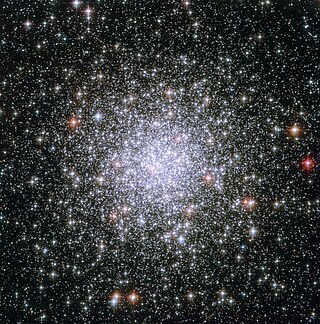
Messier 69 or M69, also known NGC 6637, is a globular cluster in the southern constellation of Sagittarius. It can be found 2.5° to the northeast of the star Epsilon Sagittarii and is dimly visible in 50 mm aperture binoculars. The cluster was discovered by Charles Messier on August 31, 1780, the same night he discovered M70. At the time, he was searching for an object described by Nicolas-Louis de Lacaille in 1751–2 and thought he had rediscovered it, but it is unclear if Lacaille actually described M69.
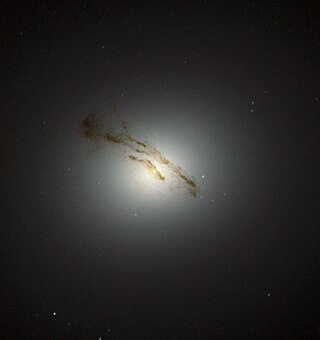
Messier 84 or M84, also known as NGC 4374, is a giant elliptical or lenticular galaxy in the constellation Virgo. Charles Messier discovered the object in 1781 in a systematic search for "nebulous objects" in the night sky. It is the 84th object in the Messier Catalogue and in the heavily populated core of the Virgo Cluster of galaxies, part of the local supercluster.

NGC 381 is an open cluster of stars in the northern constellation of Cassiopeia, located at a distance of approximately 3,120 light-years from the Sun. Credit for the discovery of this cluster was given to Caroline Herschel by her brother William in 1787, although she may never have actually seen it.
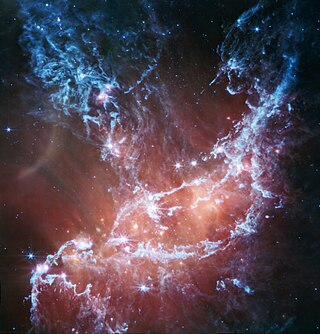
NGC 346 is a young open cluster of stars with associated nebula located in the Small Magellanic Cloud (SMC) that appears in the southern constellation of Tucana. It was discovered August 1, 1826 by Scottish astronomer James Dunlop. J. L. E. Dreyer described it as, "bright, large, very irregular figure, much brighter middle similar to double star, mottled but not resolved". On the outskirts of the cluster is the multiple star system HD 5980, one of the brightest stars in the SMC.

NGC 2506 is a mildly-elongated open cluster of stars in the equatorial constellation of Monoceros, located at a distance of 12.7 kly from the Sun near the Galactic anti-center. It was discovered by William Herschel in 1791. The cluster lies around 10,000 ly from the Galactic Center and about 1,600 ly above the Galactic plane. It is of intermediate age, estimated at around two billion years. The cluster has an angular radius of 12′ and a core radius of 4.8′.
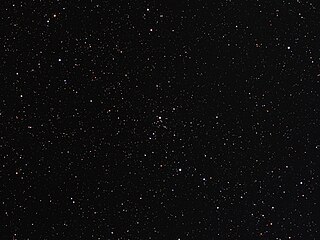
NGC 433 is an open cluster in the northern constellation of Cassiopeia, located at a distance of 6,500 light years from the Sun. It was discovered on September 29, 1829 by John Herschel, and was described by John Dreyer as "cluster, small, a little compressed." The cluster is considered on the poor side, with only 12 stars above magnitude 16. It has a linear diameter of 26.3 ly, with around 479 times the mass of the Sun and an age of 65 million years.
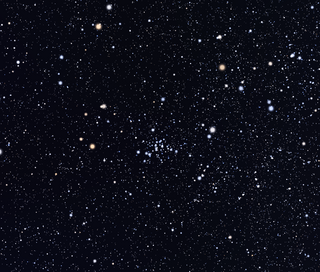
NGC 4103 is an open cluster in the constellation Crux. It was discovered by James Dunlop in 1826. It is located approximately 5,000 light years away from Earth, in the Carina-Sagittarius arm.

NGC 708 is an elliptical galaxy located 240 million light-years away in the constellation Andromeda and was discovered by astronomer William Herschel on September 21, 1786. It is classified as a cD galaxy and is the brightest member of Abell 262. NGC 708 is a weak FR I radio galaxy and is also classified as a type 2 Seyfert galaxy.






















